Hounslow spending £150 million trying to limit Heathrow plane noise from 40 local schools
Hounslow has a plane landing or taking off over it at least once per minute for most of the day. With noise loud enough to make it difficult to hold a conversation outside while a plane goes over, and loud enough to make speech and teaching difficult indoors, this is a serious problem for schools under Heathrow’s flight path. The airport is well aware of the issue, and that children have little option but to be in schools there. A teacher at a primary school some 2km from the airport’s south runway, said: “We’re in classrooms where we have to shut the blinds, we have to stop speaking, the air quality’s not very good and in the summer the temperature soars. But you can’t open the windows because of the noise, so it’s like we’re in a greenhouse melting.” Hounslow now has a £150m school rebuilding programme which aims to provide quieter classrooms in 40 schools under Heathrow’s flight path, over 5 years, partly by a heavyweight construction approach that incorporates a highly insulated concrete structural envelope. This cuts noise and gives more thermal stability. Unless there is proper ventilation, and air cooling in summer, just triple glazing and closed windows are not enough.
.
Tweet
Schools under the flight path: A breath of fresh air
Hounslow’s £150m school rebuilding programme aims to give children under Heathrow’s flight path quieter classrooms and better ventilation
Hounslow has 54 primary schools, 14 secondary schools and 5 special schools.

Source: Alamy
There is a part of the world where children are so used to aircraft taking off that when they draw aeroplanes they often depict them with the undercarriages down. These children do not live near some distant US military airbase or near one of the 30 major new airports built in China in the past five years. They live in the rather more innocuous suburban confines of the London Borough of Hounslow. And the source of their pictorial precision is none other than Heathrow Airport.
Heathrow isn’t in Hounslow; it’s in the neighbouring west London borough of Hillingdon. But as Heathrow is in Hillingdon’s southern tip and its flight path runs in an east-westerly direction, it is Hounslow lying directly to the east that bears the brunt of its aviation impact.
And it’s quite an impact too. Despite the protracted wrangling over expansion, Heathrow just about retains its position as the world’s busiest airport for international passengers and is the fourth busiest for overall traffic. This means that around 1,400 flights a day land or take off from the airport, approximately one plane every 45 seconds. And most of these descend or ascend over Hounslow.
This has obvious consequences for urban development and lifestyle within the borough with noise levels being arguably the most contentious issue. A normal conversation in a quiet room is usually around 50 decibels loud. Yet an overhead plane can emit up to 100 decibels, roughly equivalent to a domestic stereo turned up to maximum volume. This situation has led Hounslow council to frequently dub itself the “noisiest” borough in the UK.
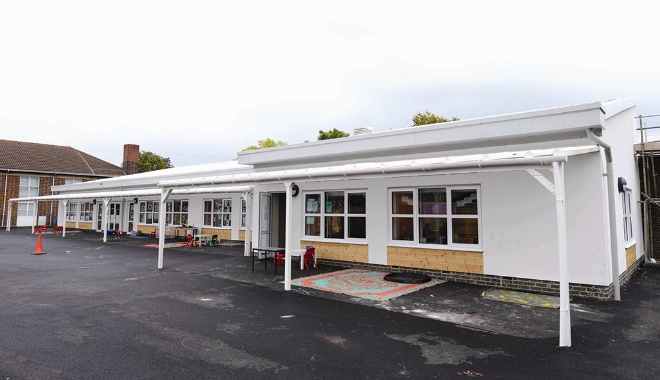
Norwood Junior School, Hounslow
While there is an obvious argument to suggest that the vast majority of people who live under Heathrow’s flight path chose to do so in the full knowledge of the airport’s proximity, clearly children attending local schools enjoyed no such choice. Dee Scott, head teacher at Beavers Primary School which is around 2,000m away from the airport’s south runway, describes the highly disruptive effect noise has on the teaching environment. “We’re in classrooms where we have to shut the blinds, we have to stop speaking, the air quality’s not very good and in the summer the temperature soars. But you can’t open the windows because of the noise, so it’s like we’re in a greenhouse melting.”
Heathrow does invest considerable sums in surrounding areas to mitigate these effects but Hounslow itself has now initiated an even more ambitious scheme. Its new £150m school rebuilding programme aims to deliver 40 new or refurbished schools over a five-year period with acoustic remediation twinned with an efficient ventilation strategy placed at the heart of the design proposals. Pick Everard was appointed as architects just before Christmas 2012.
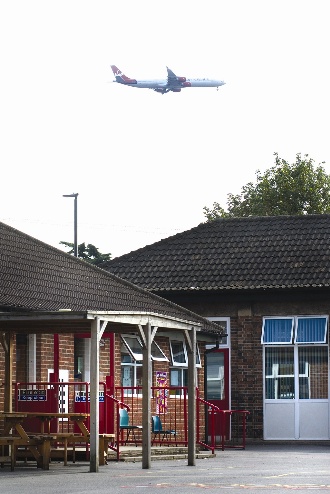
Many of the 1,400 daily flights serving Heathrow pass over Hounslow schools
Many of these schools included in the programme are located directly underneath Heathrow’s congested flight path and therefore suffer the worst effects of acoustic disruption. The schools include primary, secondary and SEN (special educational needs) schools – children who go to the last of these are particularly sensitive to excessive noise levels.
Schools are being delivered in annual phases aligned with the start of the academic year in September. Around 20 largely newbuild primary school extensions have been built so far while the remaining tranche will also include entirely newbuild secondary free schools. Due to the highly specialised nature of their acoustic requirements, all schools are being delivered via traditional contracts where a high level of design control can be exerted throughout the project.
As associate architect Steve Cummings explains, the first step was to conduct extensive acoustic surveys of each school site to indicate the level of soundproofing required at each location. “We looked at where the noise impacts the learning environment and then worked closely with our acoustic consultant who visits the different sites to measure noise at different times of the day.
“Depending on the prevailing wind direction, which can be very temperamental, aircraft may need to take off and land from an easterly or westerly direction, which has a different area of noise effect that needs to be measured and mitigated. Once the survey data was gathered, we calculated the level of sound reduction required, which informed the technical specification of the building fabric for the proposed building.”
Through this process the team made an important discovery that was to have a major impact on all subsequent design decisions. Although the method of construction chosen was clearly important, the key to achieving an acceptable acoustic environment for the school while realising cost savings at the same time was more to do with developing solutions that were both standardised and contextual.
Consequently, a standardised solution was developed for the schools but one that could be moulded to each site. The solution is refreshingly simple and low-tech. It essentially deploys a heavyweight construction approach that incorporates a highly insulated concrete structural envelope for new and extended schools. This even extends to internal blockwork walls and could be applied to existing buildings via over-cladding solutions.
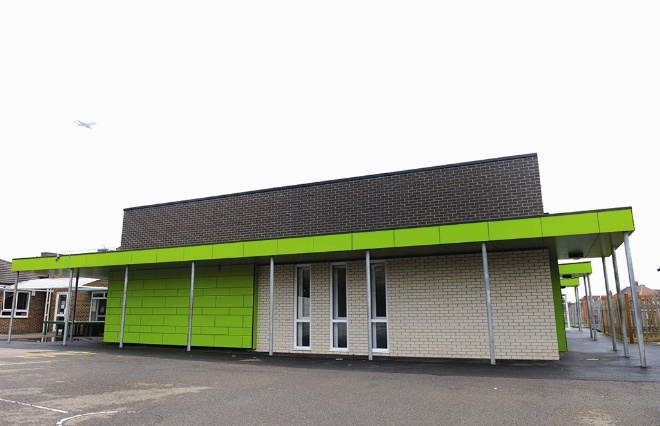
Springwell Junior School, Hounslow
This approach provided two benefits. First the heavy concrete envelope reduces internal noise impact. And second, this structure’s high thermal mass enables it to retain heat during the day and naturally cool down at night by opening the windows. The result is less reliance on mechanical ventilation to cool the building which reduces the building’s energy consumption and maintenance running costs.
Under such a strategy, despite external noise levels, windows are still obviously designed to be opened. Moreover, while this ensures that the new schools are naturally ventilated, mechanical ventilation is still deployed for the instances when outside noise still makes opening a window impossible.
But, as partner David Nisbet explains, “mechanical ventilation doesn’t provide cooling, just fresh air exchange. It’s not an overly complex solution; the mechanical ventilation is always ticking over in the background but does not require heavily serviced plant or infrastructure. We didn’t want to put teachers and pupils in an hermetically sealed box; it’s about providing an environment in which they still have choice and flexibility.”
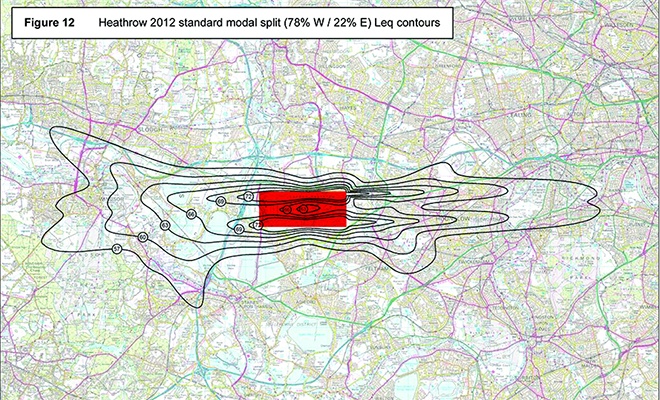
The outer contour is 57 dB Leq; the second line in is 60dB; the 3rd line is 63dB and so on.
This acoustic contours map shows the dispersal of sound in decibels over the areas surrounding Heathrow Airport (red, centre). Hounslow lies directly to the right
Cummings describes the design and ventilation strategies as a “fabric first approach that is designed to be as close to Passivhaus as possible.” He points out that by “increasingly the u-values of the walls and roof”, they were able to “design out” many of the thermal and acoustic problems the schools previously faced while still meeting BB93 (acoustics), BB101 (ventilation) and Building Regulations requirements.
As well as the heavyweight construction approach, other remedial measures to reduce noise impact included improved window specifications including triple-glazing and in some cases secondary glazing.
For Nisbet, while the heavyweight construction solution was a standardised solution, he insists that a unique design response was developed for each school that sought to give each one a unique architectural identity while satisfying its onerous acoustic requirements.
“There wasn’t one solution, each school was different and was closely engineered to meet its specific contextual as well as acoustic requirements. Standardisation was limited to construction, acoustics, fit-outs and fixtures but beyond that, there was plenty of opportunity for each school to project its own individual identity and style.”
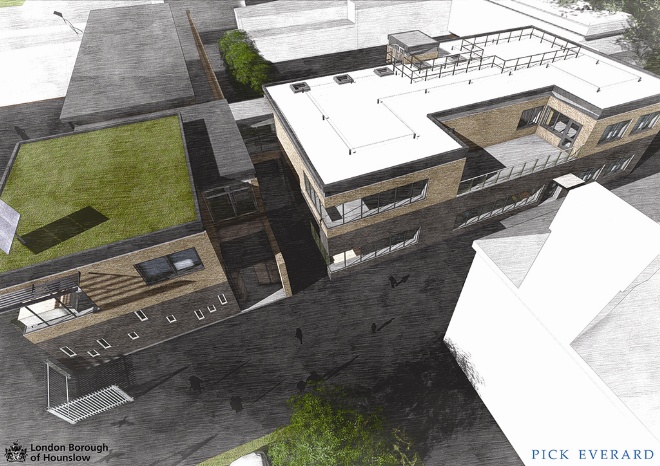
Strand on the Green will be a new secondary school that forms part of the 40 Pick Everard is providing for Hounslow
In support of this argument, Cummings points out that the heavy concrete mass was an “internal leaf approach”, therefore all manner of external finishes, such as timber or brickwork, could be applied above it without compromising its thermal or acoustic performance.
Nonetheless, with 40 schools across a borough of 275,000 people, repetition was inevitably a part of the project’s approach. But Nisbet insists it was used to its advantage. “Yes, there were definite benefits from economies of scale and from the repetition of components and materials. But it’s not just about cost efficiency; it’s about developing a series of design principles rather than specific standards and applying these as flexibly as possible across a large area.”
.
.
.
.
See also some earlier news stories about noise and schools near Heathrow:
Plane noise from Heathrow drowns out Hounslow school, as Sir Howard makes a visit
In a 2 minute video clip by the BBC, the head teacher, Dee Scott, of the Beavers Primary School in Hounslow, shows Sir Howard Davies – head of the Airports Commission, round the school. She explains to him and members of the Commission the impact another runway could have and the problems of trying to teach against the noise. The area is subjected to a plane overhead about every 90 seconds or so (noise lasting perhaps 30 seconds of that) for at least half of each school day (with westerly operations). And the problem of having to be either cool enough – with the windows open – but with noise that makes the proper function of the school impossible. OR keep the windows closed, and reduce the noise while everyone inside is uncomfortably hot. Sir Howard’s exact words in the film were that the Airports Commission has to “balance the economic interests of the many and the environmental and nuisance costs to the few”. The “few” means about 725,000 people currently affected by Heathrow noise, within the 55 decibel Lden contour and about 245,000 in the 57 decibel LAeq contour.
Click here to view full story…
.
Heathrow plans £550m sweetener which it hopes will head off opposition to 3rd runway
Heathrow airport says 950 homes in the Harmondsworth area would be demolished (compulsory purchase) if it got its north-west 3rd runway option. The media are talking about Heathrow offering substantial compensation for 750 homes. Link Heathrow is saying it will also pay large sums for sound insulation from a £550m fund and it would spend at least £250m on soundproofing homes and schools – compared with only £30m it has spent n the last 20 years. If Heathrow paid out at the level Gatwick has offered – £,000 equivalent to Band A Council Tax – to each household within the 57dB contour, it would be about £245 million per year. However much sound insulation is put in, or however many financial sweeteners, the noise is still heard if the windows are open or if people are outdoors, eg in the garden. Heathrow is still trying to work out which is less unpopular – giving more noise compensation to fewer people, or less compensation to more. John Stewart, Chair of Hacan said of Heathrow’s money offer: “Their newfound generosity is a clear sign that they are still not confident that they can get a third runway approved, agreed and built.”
Click here to view full story…
Heathrow pays £1.8m for noise-reducing adobe huts in playgrounds of 21 schools under its flightpaths
November 9, 2013
It was reported in April 2013 that four adobe domes had been put up in the grounds of Hounslow Primary school, which is under the southern runway at Heathrow, in order to enable the children to use the playground despite the plane noise. Now Heathrow says it will spend £1.8 million to extend the scheme to 21 schools that are badly affected by aircraft noise. Heathrow is desperate to try and persuade London residents that aircraft noise is being dealt with, and a 3rd runway will not cause intolerable noise to those overflown. The 21 schools, which have not been named, will each get around £85,000 for the building of these structures. The largest can hold 30 children, and the level of noise can be 17 decibels lower than outside. Children can hear the teachers inside the domes, so teaching does not have to stop for a considerable time every 90 seconds or so, when planes go over. Children can also hear each other, and so develop their language skills. However, the domes do not solve the problem of providing ventilation and soundproofing of classrooms.
Click here to view full story…
.
Noise Exposure Contours for Heathrow Airport 2012 published
29.9.2013
Prepared by the Civil Aviation Authority on behalf of the Department for Transport, September 2013. The report summary says: This report presents the year 2012 noise exposure contours for London Heathrow Airport. The 57 dBA Leq contour area for 2012 based on the actual runway modal split was calculated to be 110.1 km2 , 1% higher than in 2011. The population enclosed within the actual 57 dBA contour decreased by 2% compared to 2011 to 239,600. P22 of the CAA noise study for Heathrow says (comparing 2012 to 2011) there were 2% less people in the 57 dBA contour, 2% more in the 60 dbA contour.
P21 of the CAA noise study https://www.gov.uk/government/uploads/system/uploads/attachment_data/file/244529/lhr-2012.pdf …
shows in 2012 there were 57 schools in 60 dBA area and 150 schools in the 57 dBA area
.
.
Adobe earth houses in school playground give pupils refuge from Heathrow noise
April 23, 2013
Pupils at the Hounslow Heath Infant school ( children aged 3 – 7) just under a Heathrow flight path, have very loud and intrusive aircraft noise from the planes flying some 180 metres approx overhead. The problem is so bad that BAA (as it was) paid for the construction of some adobe structures in the playground, so the children can spend at least part of their time outdoors in places where they can hear each other speak. At some times of day, there is aircraft noise for 25 seconds out of every 90 seconds. Classes of up to 30 children can be seated inside the main dome, and inside the noise is reduced by some 17 decibels. Outdoor learning is valued by teachers and is also a statutory part of the national curriculum. The headteacher said the adobe structures are important as refuges because “When kids are playing they are also developing their language skills, and in the playground again they’re being interrupted.” Schools should not be located under flight paths where planes are low.
Click here to view full story.
.
Fear that ‘Heathrow noise reduces pupil learning by third’ – as Hounslow opens its Heathrow consultation
April 15, 2013
The head teacher of an infant and nursery school directly under a Heathrow flight path, close to the airport in Hounslow, has been speaking of the impact of the planes on the learning of children at her school. Kathryn Harper-Quinn, who runs Hounslow Heath Infant & Nursery School said a recent study had highlighted the dramatic impact planes thundering 600-feet overhead have on children’s learning. Asked to recall factual details from an outdoor lesson, she said, a class of 7-year-olds could remember about a third less than those hearing the same lesson in a specially built noise-insulated hut. When the study was repeated with a fictional story, there was no noticeable difference in performance – a result Ms Harper-Quinn put down to pupils being able to fill in the gaps more easily. Speaking at the official launch of Hounslow Council’s consultation on Heathrow, she claimed a 3rd runway would blight thousands more children’s education. The consultation questionnaire contains 11 questions, and the deadline for responses is May 16th.
Click here to view full story…
.
Heathrow noise ‘hinders pupils’ reading progress’ – would only worsen with more runways and fights
March 28, 2013
Children living under the Heathrow flight path are suffering two-month lags in their reading development as a result of aircraft noise. Hounslow council says pupils in the borough have to put up with “continual disruption”, and warned the problem will worsen if the airport expands to three or more runways. Around 40 schools are directly under the Heathrow flight paths with planes landing every 90 seconds or so much of the day. The council cites an international study by London University into aircraft noise which found it led to a “significant impairment” in reading development, as well as affecting long-term memory and motivation. As well as a 2-month delay in reading, the children’s education is suffering from the continual disruption from low-flying jets. If schools don’t have triple glazing the interruptions to lessons can be relentless. One school near the airport has had shelters installed in the playground so children can escape the noise. A 2010 ECRD study suggested that chronic aircraft noise has a deleterious effect on memory, sustained attention, reading comprehension and reading ability.
Click here to view full story…
.
.
Also from Pick Everard:
9 July 2014
Hounslow school’s expansion programme well underway
With demand for primary school places already outstripping supply in Hounslow, the first phase of a multi-million pound expansion programme is set to complete in July this year.
The London Borough of Hounslow penned a deal with multi-disciplinary management and design partnership, Pick Everard in December 2012 to provide project & cost management and design services under the Government Procurement Services Framework, to deliver multiple new primary and SEN school places over the next five years within challenging cost parameters.
Pick Everard has been working on an initial ten primary schools identified by the borough to launch the expansion and improvement programme in the area, ready for September’s intake.
The initial schools provide unique challenges to the firm as they are located within the flight path for Heathrow Airport and, as a result, require significant soundproofing and ventilation work to take place to ensure a high quality learning environment for pupils.
Allan Cowie, director at Pick Everard said: “This schools programme is hugely significant to the firm and really takes advantage of the wealth of experience we have in delivering projects to the education sector.
“The initial schools are particularly interesting because of their location – we are working really hard with both the London Borough of Hounslow and Heathrow Airport to make sure that the schools are all sufficiently sound-proofed from the aircraft noise throughout the school day.
“It poses us with some challenges, such as how to provide adequate ventilation for the classrooms where it’s not possible to open a window due to the external noise levels – our approach using proven modern construction techniques and energy efficient ventilation strategies ensure the provision of high quality learning environments for children’s education.”
“Pick Everard have focussed on a standardised design strategy, aimed at providing efficiencies in both time and money across the programme. We have analysed a range of appropriate construction methods against a back drop of very challenging geographic constraints and produced cost effective, innovative and extremely high quality design solutions.”
The first phase of the programme is due for completion in July after which work will begin on a second tranche of schools for delivery by September 2015 at a combined value of approximately £30 million. Pick Everard has also completed feasibility studies for schools required for September 2016 and beyond.
“We will be working on a total of 40 projects at a combined cost of more than £150 million, including a range of primary, secondary and SEN schools which will involve a series of expansions and feasibility studies being completed over a five year period,” added Allan.
“More than 30 per cent of our company’s work is now in the education sector and we have a great deal of experience within London particularly – we have completed 176 school projects just within the M25 in the past four years alone.
“The increased demand for school places is not unique to London by any means. It is something that is happening across the whole of the UK. With population levels on the rise, and the recession keeping more people within London to take advantage of the increased number of job opportunities, the pressure on the capital is increasing.
“Local authorities are increasingly coming under pressure to provide more school places to accommodate a growing number of pupils – giving rise to the need for school expansions and improvements such as those we are involved in for the London Borough of Hounslow.”
Work is currently underway at: Norwood Green Infant and Nursery School, Norwood Green Junior School, Springwell Infant & Nursery, Sparrow Farm Infant and Nursery School, Sparrow Farm Junior School, Springwell Junior, Feltham Hill Infant & Nursery, Feltham Hill Junior, Grove Park Primary and Crane Park Primary.
http://www.pickeverard.co.uk/news/2014/Hounslow-expansion-underway.html
.
.
.
